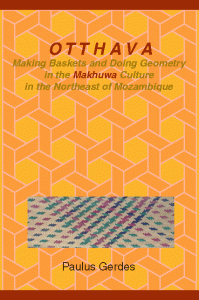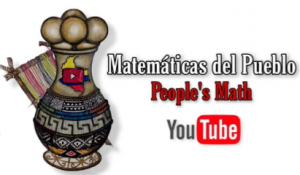Libro: OTTHAVA: Making Baskets and Doing Geometry in the Makhuwa Culture in the Northeast of Mozambique
Author: Paulus Gerdes
ISBN: 978-0-557-38290-3, 2010, 292 pp
together with the full-colour supplement: «OTTHAVA Images in Colour» (ISBN 978-0-557-38292-7, 2010, 68 pp.)
Preface: Dr. Abdulcarimo Ismael (Academic Director, Lurio University);
Afterword: Dr. Mateus Katupha (Minister of Culture, Youth and Sports, 1991-2000)
Available from http://stores.lulu.com/pgerdes
Backcover text:
In the book “Otthava: Making Baskets and Doing Geometry in the Makhuwa Culture in the Northeast of Mozambique” I reflect on practices in the Makhuwa culture, which provide evidence of the geometric considerations operating in basket weaving, and are suitable and appropriate for mathematical and educational exploration. A proper scientific understanding of this knowledge, and the educational value of these manifestations may lead to a better appreciation of the Makhuwa culture, and its contribution to Mozambican culture as a whole.
The practices I present in this book belong to the cultural sphere of ‘otthava’ – weaving, plaiting, interweaving, interlacing, braiding – that is, to basket- and mat- weaving. The topics which are analysed are the making of funnels (Chapter 1), hats (Chapter 2), fish traps (Chapter 3), containers (Chapter 4), trays (Chapter 5), dance rattles (Chapter 6), purses (Chapter 7), decorated braids (Chapter 8), baskets and handbags (Chapters 9 and 10), knots (Chapter 11) and circular mats (Appendix 3).
In each chapter, I propose possible ways in which to explore and value, both scientifically and educationally, the geometrical knowledge inherent in the cultural practices under consideration. For instance, symmetries, polygons and polyhedra, spirals, cylinders, helices, band- and plane patterns are analysed.
The chapters of this book may be read (and re-read) in practically any order. The reading may prove to be more productive if the reader tries to solve the various problems, which are provided.
I have written this book for a very varied public: for all who are interested in the Makhuwa culture; for those who would like to know more about some aspects of the Mozambican culture, which is constantly and dynamically under construction; for teachers and future teachers of mathematics, for students and (future) lovers of mathematics and of geometry in particular.
The first two Makhuwa scholars awarded doctorates for theses about the Makhuwa culture, have written, respectively, the Afterword and the Preface of the book: the linguist Mateus Katupha, Minister of Culture, Youth and Sports (1991-2000), and the ethnomathematician Abdulcarimo Ismael.



